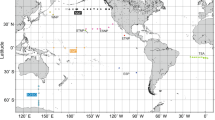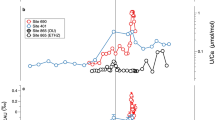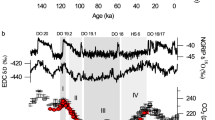Abstract
THREE decades after the first study of nitrous oxide (N2O) in the ocean1, the marine geochemistry of this compound is of exceptional interest for two reasons: first, the need to understand the role of N2O in both nitrification and denitrification in the sea2–5, and second, the importance of N2O in the stratospheric ozone cycle6 and as a greenhouse trace gas that, molecule for molecule, is 200 times more effective than carbon dioxide7. Related questions concern the role of the ocean as a source or sink of tropospheric N2O and the processes responsible for its production and consumption in the sea. Our approach to these problems is one that has been successful in studies of H2O geochemistry8 and sources of atmospheric CO (ref. 9): the simultaneous study of two isotopic components of a molecule, here the 15N/14N and 18O/16O ratios. We have measured these ratios in N2O in three Pacific Ocean profiles and in Pacific marine air. Relative to atmospheric N2O, dissolved N2O is slightly depleted in both heavy isotopes down to a depth of ∼600m, but in deep and bottom water, N2O is everywhere enriched in 15N and 18O. Thus, contrary to recent predictions10,11, N2O production in deep water is characterized by heavy-isotope enrichment in both nitrogen and oxygen. These enrichments may be due to microbial reduction of N2O produced by nitrification, or they may reflect a prior 15N, 18O enrichment in an intermediate compound (for example, NH2OH) from which the light isotopes are preferentially channelled into nitrite and nitrate during nitrification.
This is a preview of subscription content, access via your institution
Access options
Subscribe to this journal
Receive 51 print issues and online access
$199.00 per year
only $3.90 per issue
Buy this article
- Purchase on Springer Link
- Instant access to full article PDF
Prices may be subject to local taxes which are calculated during checkout
Similar content being viewed by others
References
Craig, H. & Gordon, L. I. Geochim. cosmochim. Acta 27, 949–955 (1963).
Yoshinari, T. Mar. Chem. 4, 189–202 (1976).
Cohen, Y. & Gordon, L. I. Deep Sea Res. 25, 509–524 (1978).
Elkins, J. W., Wofsy, S. C., McElroy, M. B., Kolb, C. E. & Kaplan, W. A. Nature 275, 602–606 (1978).
Cohen, Y. & Gordon, L. I. J. geophys. Res. 84, 347–353 (1979).
Crutzen, P. J. Q. Jl R. met. Soc. 96, 320–325 (1970).
Lacis, A. A., Hansen, J., Lee, P., Mitchell, T. & Lebedeff, S. Geophys. Res. Lett. 8, 1035–1038 (1981).
Craig, H. Science 133, 1702–1703 (1961).
Stevens, C. M. et al. Earth planet. Sci. Lett. 16, 147–165 (1972).
Yoshida, N., Hattori, A., Saino, T., Matsuo, S. & Wada, E. Nature 307, 442–444 (1984).
Yoshida, N. Nature 335, 528–529 (1988).
Broecker, W. S., Spencer, D. W. & Craig, H. Geosecs Vol. 3: Pacific Expedition Hydrographic Data (National Science Foundation, Washington, DC, 1982).
Craig, H. & Weiss, R. F. J. geophys. Res. 75, 7641–7647 (1970).
Craig, H., Kim, K., Loosli, H. H., Weidman, U. & Kalt, P. Eos 64, 736 (1983).
Wahlen, M. & Yoshinari, T. Nature 313, 780–782 (1985).
Craig, H. J. geophys. Res. 76, 5078–5086 (1971).
Yoshinari, T. & Wahlen, M. Nature 317, 349–350 (1985).
Kroopnick, P. & Craig, H. Earth planet. Sci. Lett. 32, 375–388 (1976).
Hollocher, T. C., Tate, M. E. & Nicholas, D. J. D. J. biol. Chem. 256, 10834–10836 (1981).
Yoshida, N. et al. Nature 342, 895–897 (1989).
Kaplan, W. A. & Wofsy, S. C. in Advances in Aquatic Microbiology Vol. 3, (eds Jannasch, H. W. & Williams, P. J.) 181–206 (Academic, London, 1985).
Fenchel, T. & Blackburn, T. H. Bacteria and Mineral Cycling (Academic, London, 1979).
Butler, J., Elkins, J. W., Thompson, T. M. & Egan, K. B. J. geophys. Res. 94, 14865–14877 (1989).
Cline, J. D. & Kaplan, I. R. Mar. Chem. 3, 271–299 (1975).
Weiss, R. F. Eos 62, 894 (1981).
Cline, J. D., Wisegarver, D. P. & Kelly-Hansen, K. Deep Sea Res. 34, 857–873 (1987).
Kroopnick, P. & Craig, H. Science 175, 54–55 (1972).
Miyake, Y. & Wada, E. Records Oceanogr. Works Japan 9, 37–53 (1967).
Yoshida, N. & Matuso, S. Geochem. J. 17, 231–239 (1983).
Author information
Authors and Affiliations
Rights and permissions
About this article
Cite this article
Kim, KR., Craig, H. Two-isotope characterization of N20 in the Pacific Ocean and constraints on its origin in deep water. Nature 347, 58–61 (1990). https://doi.org/10.1038/347058a0
Received:
Accepted:
Issue Date:
DOI: https://doi.org/10.1038/347058a0
This article is cited by
-
Food web structure and trophic levels in a saltwater pond sea cucumber and prawn polyculture system
Acta Oceanologica Sinica (2016)
-
Food web structure and trophic levels in polyculture rice-crab fields
Chinese Journal of Oceanology and Limnology (2015)
-
Isotopic constraints on marine and terrestrial N2O emissions during the last deglaciation
Nature (2014)
-
Temporal and spatial variations of δ 15N and δ 18O for atmospheric N2O above the oceanic surface from Shanghai to Antarctica
Science in China Series D: Earth Sciences (2008)
Comments
By submitting a comment you agree to abide by our Terms and Community Guidelines. If you find something abusive or that does not comply with our terms or guidelines please flag it as inappropriate.



